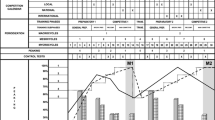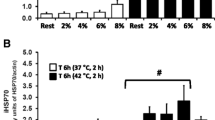Summary
The aim of this study was a detailed examination of the effects of moderate exercise on T-cells in adult male Wistar rats. The T-cell populations were compared in sedentary rats (C, n = 5) and in rats trained for 4 weeks on a treadmill (30–60 min·day−1, 6 days·week−1, 20–30 m·min−1) and sacrificed at rest (Trest, n=5). In the T-rest rats, there were higher percentages of CD4+CD8−, CD4− CD8 + and CD4 − CD8 −thymocytes (P<0.05, P<0.05 and P<0.01 respectively) and of CD4−CD8 + splenocytes (P< 0.01), and a lower percentage of CD4−CD8+ cells in the lymph nodes (P<0.01). Compared with T-rest or C rats, trained rats (n = 5) or untrained rats (n = 5) sacrificed immediately after a running session (60 min, 30 m·min−1) had a higher percentage of mononucleated cells CD4 + CD8 -in the blood (P<0.05 and P<0.01). Lastly, compared with C rats, rats (n=5) sacrificed immediately after their 5th day of training (30–60 min·day−1) presented a higher total splenocyte population (P<0.05) and greater in vitro production of T-cell growth factor (interleukin 2 + interleucin 4) by splenocytes in response to a mitogen (P<0.01). These results would indicate that moderate endurance training modifies the cellular composition of lymphoid organs, without impairing the in vitro functions of T-cells.
Similar content being viewed by others
References
Andersen DH (1935) The effect of food and of exhaustion on the pituary, thyroid, adrenal and thymus glands of the rat. J Physiol (Lond) 85:162–167
Fernandez G, Rozek M, Troyer D (1986) Reduction of blood pressure and restoration of T-cell immune function in spontaneously hypertensive rats by food restriction and/or by treadmill exercise. J Hyperts 4 [Suppl 3]:S469-S474
Ferry A, Weill B, Rieu M (1990) Immunomodulation in rats induced by exercise on a treadmill. J Appl Physiol 69:1912–1915
Ferry A, Rieu P, Laziri F, Guezennec CY, El Habazi A, Le Page C, Rieu M (1991) Immunomodulations of thymocytes and splenocytes in trained rats. J Appl Physiol 71:815–820
Ferry A, Weill B, Amiridis I, Laziri F, Rieu M (1991b) Splenic immunomodulation with swimming-induced stress in rats. Immunol Lett 26:261–264
Green RL, Kaplan SS, Rabin BS, Stanitski CL, Zdziarski U (1981) Immune functions in marathon runners. Ann Allergy 47:73–75
Haar PM, Pedersen BK, Fomsgaard A, Tvede N, Diamant M, Klarlund K, Halkjaer-Kristensen J, Bendtzen B (1991) Int J Sports Med 12:223–227
Hoffman-Goetz L, Keir R, Thorne R, Houston ME, Young C (1986) Chronic exercise stress depresses splenic T lymphocyte mitogenesis in vitro. Clin Exp Immunol 66:551–557
Hoffman-Goetz L, Thorne R, Randall-Simpson JA, Arumugan Y (1989) Exercise stress alters murine lymphocyte subset distribution in spleen, lymph nodes and thymus. Clin Exp Immunol 76:307–310
Huning T, Wallny HJ, Hartley JK, Lawetzky A, Tiefenthaler G (1989) A monoclonal antibody to a constant determinant of the rat T cell antigen receptor that induces T cell activation. J Exp Med 169:73–86
Lewicki R, Tchorzewski H, Majewska E, Nowak Z, Baj Z (1988) Effect of maximal physical exercise on T-lymphocyte subpopulations and on interleukin 1 (ILl) and interleukin 2 (IL2) production in vitro. Int J Sports Med 9:114–117
Mosmann T (1983) Rapid colorimetrie assay for cellular growth and survival: application to proliferation and cytotoxicity assays. J Immunol Methods 65:55–63
Olsen NJ, Watson MB, Henderson GS, Kovacs WJ (1991) Androgen deprivation induces phenotypic and functional changes in the thymus of adult male mice. Endocrinology 129:2471–2476
Pabst R, Binns RM (1989) Heterogeneity of lymphocyte homing physiology: several mechanism operate in the control of migration to lymphoid and non-lymphoid organ in vivo. Immunol Rev 108:83–108
Pahlavani MA, Cheung TK, Chesky JA, Richardson A (1988) Influence of exercise on the immune function of rats of various ages. J Appl Physiol 64:1997–2001
Pedersen BK (1991) Influence of physical activity on the cellular immune system: mechanism of action. Int J Sports Med 12 [Suppl 1]:823–829
Reyes MP, Lerner AM, Ho KL (1981) Diminution in the size of the thymus during forced swimming. J Infect Dis 143:292
Screpanti I, Morrone S, Meco D, Santoni A, Gulino A, Paolini R, Crisanti A, Mathieson BJ, Frati L (1989) Steroid sensitivity of thymocyte subpopulations during intrathymic differentiation. J Immunol 142:3378–3383
Selye H (1976) Stress in health and disease. Butterworth, Boston, Mass.
Tharp G, Preuss TL (1991) Mitogenic response of T-lymphocytes to exercise training and stress. J Appl Physiol 70:2535–2538
Teshima H, Sogawa H, Kihara H, Kubo C, Nakawa T (1991) Changes in T-cell subpopulations induced by autonomic neurotransmitters and hormone. Fukuoka Acta Med 82:428–436
Author information
Authors and Affiliations
Rights and permissions
About this article
Cite this article
Ferry, A., Rieu, P., Laziri, F. et al. Effect of moderate exercise on rat T-cells. Europ. J. Appl. Physiol. 65, 464–468 (1992). https://doi.org/10.1007/BF00243515
Accepted:
Issue Date:
DOI: https://doi.org/10.1007/BF00243515




